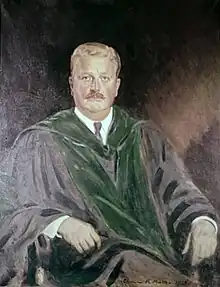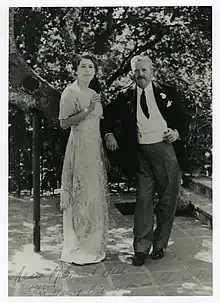Logan Clendening | |
|---|---|
 Oil Portrait of Clendening, c. 1939 | |
| Born | May 25, 1884 Kansas City, Missouri, U.S. |
| Died | January 31, 1945 (aged 60) Kansas City, Missouri, U.S. |
| Resting place | Independence, Missouri, U.S. |
| Alma mater | University of Kansas (M.D.) |
| Occupations | |
| Spouse |
Dorothy Scott Hixon (m. 1914) |
| Children | 1 |
Logan Clendening (May 25, 1884 – January 31, 1945) was an American physician, historian, and medical writer.
Family
The Clendening family were staunch Jacobites, fleeing Scotland after the fall of King James II of England. As a child, Clendening recalled his grandfather parading up and down the family street wearing a white rose in his buttonhole and vowing "confusion to the Hanoverian usurpers" every year on June 10.[1]
Early life
_(cropped).png.webp)

Logan Clendening was born on May 25, 1884, in Kansas City, Missouri. He was the son of Lide (née Logan) and Edwin McKaig Clendening. His father was a merchant and served as president of the Kansas City Commercial Club.[2][3] He was educated in the Kansas City Public Schools, going on to study at the University of Michigan and the University of Kansas. In 1907, he received a Doctor of Medicine from the University of Kansas.[1]
Career
Clendening was Professor of Clinical Medicine and Professor of Medical History at the University of Kansas School of Medicine, later part of the University of Kansas Medical Center.[1] He held an instructorship at the institution from 1912 until his death in 1945.
In 1911, Clendening joined the Army Medical Corps Reserve as a first lieutenant. He was called up on June 5, 1917, and served first as a captain, then a major at Fort Sam Houston in the U.S. Army Medical Corps. He was discharged in December 1918.[1][4] Clendening was the author of the successful book The Human Body, in 1945 it was noted that one and a half million copies had been sold.[1] He became well known for his medical journalism and columns that appeared in many daily newspapers. He took interest in collecting old medical textbooks, researching the Shakespeare authorship question and studying the writings of Charles Dickens, and Arthur Conan Doyle's Sherlock Holmes stories.[1]
The University of Kansas Medical Center has described Clendening as "the greatest popularizer of Medicine in America in the first half of the twentieth century."[4]
Personal life

In the early 1910s he met Dorothy Scott Hixon, the daughter of Frank Pennell Hixon, a wealthy lumber and banking baron from LaCrosse, Wisconsin. They courted long-distance for several years, and married on July 22, 1914. On July 4, 1920, their only child was born premature. She died after a few hours.[5]
Through the publication of his first book, Modern Methods of Treatment, in 1924, Clendening became friends with H.L. Mencken, who encouraged his career as a popular medical writer.[1]
In his later years, Clendening suffered from depression and failing health. On January 31, 1945, he committed suicide by cutting his throat and wrists with a knife.[6][7]
Publications
- The Human Body (1927)
- Modern Methods Of Treatment (1928)
- Behind the Doctor (1933)[8]
- The Care and Feeding of Adults (1933)
- Handbook To Pickwick Papers (1936)
- The Balanced Diet (1936)
- Workbook in Elementary Diagnosis for Teaching Clinical History Recording and Physical Diagnosis (1938)
- Source Book of Medical History (1942, 1960)[9][10]
- The Logan Clendening Collection of Books About the Bacon-Shakespeare Controversy (1943)
- Methods Of Diagnosis (1947) [with Edward H. Hashinger]
References
- 1 2 3 4 5 6 7 Major, Ralph H. (1945). Logan Clendening 1884-1945. Bulletin of the Medical Library Association 33 (2): 257-259.
- ↑ Creel, George; Slavens, John (1902). Men Who Are Making Kansas City. p. 20. Retrieved October 8, 2022.
- ↑ Wilson, Philip K. "Logan Clendening". American National Biography.
- 1 2 Hulston, Nancy. "Logan Clendening’s Unattainable War". University of Kansas Medical Center.. University of Kansas Medical Center.
- ↑ Paxton, Heath N. (October 31, 2020). "Toast to Olde Tymes: Logan Clendening". The Independent.
- ↑ "Logan Clendening". The Pendergast Years.
- ↑ "Logan Clendening Canonizing an Irregular Saint". Baker Street Journal, 1992.
- ↑ "Behind the Doctor". Kirkus Reviews.
- ↑ Leikind, Morris C. (1942). Reviewed Work: Source Book of Medical History. The American Historical Review 48 (1): 61-62.
- ↑ Galdston, Iago. (1942). Source Book of Medical History. American Journal of Public Health and the Nation's Health 32 (9): 1054.